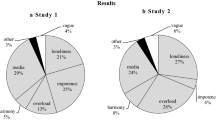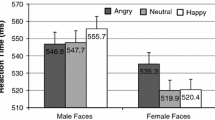Abstract
The relation of gender to crying was investigated over a 15-year interval. The 1996 sample was composed of 523 undergraduates (293 females and 230 males). Forty percent of the sample described themselves as Asian, 32% Anglo, 19% Hispanic, and 7% African American. There were extreme similarities between the 1981 and 1996 samples in terms of reported frequency and intensity of crying and the gender patterning of crying behavior across stimulus situations. In the later sample, gender role orientation (as measured by the BSRI) was found to be associated with crying. Neither ethnicity nor socioeconomic status was significantly related to any of the variables examined. It may be that crying has not been significantly affected by changing gender role expectations in the last 15 years.
Similar content being viewed by others
REFERENCES
Balswick, J. (1988). The inexpressive male. Lexington, MA: Lexington Books.
Barnett, R. C., & Rivers, C. (1996). She works, he works: How two-income families are happier, healthier, and better off. San Francisco: HarperCollins.
Bem, S. L. (1974). The measure of psychological androgyny. Journal of Consulting and Clinical Psychology, 42, 155-162.
Biegler, G. R. (1985). Bem sex-role inventory. In D. J. Keyser & R. C. Sweetland (Eds.), Test critiques (Vol. III). Kansas City, MO: Test Corporation of America.
Bindra, D. (1972). Weeping: A problem of many facets. Bulletin of the British Psychological Society, 25, 281-284.
Brody, L. R. (1997). Gender and emotion: Beyond stereotypes. Journal of Social Issues, 53(2), 369-394.
Brody, L. R. (1999). Gender, emotion, and the family. Cambridge, MA: Harvard University Press.
Coontz, S. (1997). The way we really are. New York: Basic Books.
Ekman, P., Friesen, W. V., & Ellsworth, P. (1972). Emotion in the human face: Guidelines for research and an integration of findings. Elmsford, NY: Pergamon.
Feingold, A. (1992). Cognitive gender differences:Adevelopmental perspective. Sex Roles, 29, 91-112.
Fischer, A., & Manstead, S. R. (2000). The relation between gender and emotions in different cultures. In A. H. Fischer (Ed.), Gender and emotion: Social psychological perspectives (pp. 71-94). Cambridge, UK: Cambridge University Press.
Frey, W. H., & Langseth, M. (1985). Crying: The mystery of tears. Minneapolis, MN: Winston.
Fuchs, D., & Thalen, M. H. (1988). Children's expected interpersonal consequences of communicating their affective state and reported likelihood of expression. Child Development, 59, 1314-1322.
Goffman, E. (1959). Strategic interaction. Philadelphia, PA: University of Philadelphia.
Hastrup, J. L., Payne, T. J., & Yanuskiewietz, B. I. (1988, April). Self-monitored crying behavior: Relationships to sex role stereotypy. Paper presented at the meeting of the Eastern Psychological Association, Buffalo, NY.
Hochschild, A. R. (1979). Emotion work, feeling rules, and social structure. American Journal of Sociology, 85(3), 551-575.
Hochschild, A. R. (1983). The managed heart: The commercialization of human feeling. Berkeley, CA: University of California Press.
Hochschild, A. R. (1990). Ideology and emotion management: A perspective and path for future research. In T. D. Kemper (Ed.), Research agendas in the sociology of emotions (pp. 117-142).NY: State University of New York.
Katz, J. (2000). How emotions work. Chicago: University of Chicago.
Kraemer, D. L., & Hastrup, J. L. (1986). Crying in natural settings: Global estimates, selfmonitored frequencies, depression and sex differences in an undergraduate population. Behavior Research and Therapy, 24, 371-373.
Labott, S. M., & Martin, R. B. (1988). Weeping: Evidence for a cognitive theory. Motivation and Emotion, 12, 205-216.
Labott, S. M., Martin, R. B., Eason, P. S., & Berkey, E. Y. (1991). Social reactions to the expression of emotion. Cognition and Emotion, 5, 397-417.
LaFrance, M., & Banaji, M. (1992). Toward a reconsideration of the gender-emotion relationship.In M. S. Clark (Ed.), Emotion and social behavior. Newbury Park, CA: Sage.
Larson, R., & Pleck, J. (1999). Hidden feelings: Emotionality in boys and men. In D. Bernstein (Ed.), Nebraska Symposium on Motivation: Vol. 45. Gender and motivation (pp. 25-74). Lincoln, NE: University of Nebraska Press.
Lombardo, W. K., Cretser, G. A., Lombardo, B., & Mathis, S. L. (1983). For cryin'out loud-there is a sex difference. Sex Roles, 9, 987-995.
Long, J. S. (1993). Regression models for categorical and limited dependent variables. Thousand Oaks, CA: Sage.
McCullagh, P., & Nelder, J. A. (1989). Generalized linear models (2nd ed.). London: Chapman and Hall.
Rosenblatt, P. C., Walsh, R. P., & Jackson, D. A. (1976). Grief and mourning in cross-cultural perspective. New Haven, CT: HRAF.
Ross, C. E., & Mirowsky, J. (1984). Men who cry. Social Psychology Quarterly, 47(2), 138-146.
Scherer, K. R., Wallbott, H.G., & Summerfield, A.B. (1986). Experiencing emotion. Cambridge, UK: Cambridge University Press.
Spence, J. T., Helmreich, R. L., & Stapp, J. (1974). Ratings of self and person sex-role attributes and their relation to self-esteem and conceptions of masculinity and femininity. Journal of Personality and Social Psychology, 32, 29-39.
Stacey, J. (1996). In the name of the family: Rethinking family values in a post-modern age. Boston: Beacon.
Tavris, C. (1999). The science and politics of gender research: The meanings of difference. In D. Bernstein (Ed.), Nebraska Symposium on Motivation: Vol. 45. Gender and motivation (pp. 1-23). Lincoln, NE: University of Nebraska.
Thoits, P. A. (1989). The sociology of emotion. Annual Review of Sociology, 15, 317-342.
Thoits, P. A. (1990). Emotional deviance: Research agendas. In T. D. Kemper (Ed.), Research agendas in the sociology of emotions (pp. 180-203). NY: State University of New York.
Vingerhoets, A., & Scheirs, J. (2000). Sex differences in crying: Empirical findings and possible explanations. In A.H. Fischer (Ed.), Gender and emotion: Social psychological perspectives (pp. 143-165), Cambridge, UK: Cambridge University Press.
Williams, D. G., & Morris, G. H. (1996). Weeping or tearfulness in British and Israeli adults. British Journal of Psychology, 87, 479-505.




